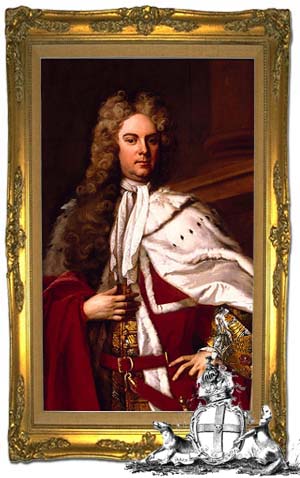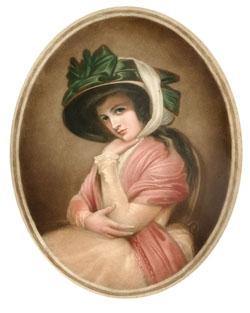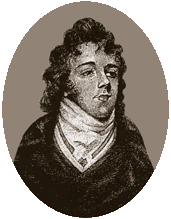James Brydges: Cassanda Austen's Princely Uncle

James Brydges, 1st Duke of Chandos, MP, PC (6 January 1673 – 9 August 1744) was the first of fourteen children by Sir James Brydges, 3rd Baronet of Wilton Castle, Sheriff of Herefordshire, 8th Baron Chandos; and Elizabeth Barnard. Three days after his father's death on 16 October 1714, when he became 9th Baron Chandos, he was created 1st Viscount Wilton and 1st Earl of Carnarvon; he became 1st Duke of Chandos and 1st Marquess of Carnarvon in 1719. He was a Member of Parliament for Hereford from 1698 to 1714. The rise and fall of Henry James Brydges, first duke of Chandos, provides as worthy a subject as any for a film or television drama. Within the space of ten years, from say 1710 to 1720, he rose to fame and riches, only to descend into relative obscurity following the loss of his wealth which was equally as dramatic as the gaining of it. Along the way he created one of baroque London's most palatial mansions, and was responsible for bequeathing to posterity the inestimable gift of Handel's Chandos Anthems. Born in 1673 the son of a Herefordshire squire, in 1696 he married his cousin, Mary Lake (c.1666-1712), who brought to the marriage the manor known as Canons as part of her dowry. Two years after his marriage to Mary Lake, Brydges became Member of Parliament for Hereford. He rose by force of personality, administrative ability and the favour of the Duke of Marlborough to become Paymaster of the Forces Abroad during the War of the Spanish Succession. The Paymaster was able to speculate with the monies he received, and by the time he left the post in 1713 Brydges had accumulated a fortune estimated at £600,000, a sum having in the year 1713 the same purchasing power as £58 million, or $95 million today.  One of the improvements Chandos made to the estate was the expansion of the gardens and addition of several Water features. Chandos had a passion for exotic plants and was one of the first to grow coffee and pineapples in England. He was aided in his attempts by Sir Matthew Decker, a Dutchman living in England and a director of the East India Company. Decker is credited as the first man to grow pineapples on English soil.
One of the improvements Chandos made to the estate was the expansion of the gardens and addition of several Water features. Chandos had a passion for exotic plants and was one of the first to grow coffee and pineapples in England. He was aided in his attempts by Sir Matthew Decker, a Dutchman living in England and a director of the East India Company. Decker is credited as the first man to grow pineapples on English soil.  Many readers of Jane Austen's life and letters will recall the name Brydges as it appears frequently in print. Austen's own mother, another Cassandra (named, perhaps, for her illustrious ancestor), was a great-neice of the Duke and maintained a relationship with many of the Brydges family, including Brookes Brydges, who, perhaps, had an interest in Jane. By this time, Cassandra had become a family name, bestowed on Austen's own elder sister, a cousin and three of her nieces. These Brydges were not related to Austen's sister-in-law, Elizabeth Bridges Austen Knight of Goodnestone. On August 4th, the same year that Lord Brydges was made a Duke, he secured the services of who joined the Chapelmaster Dr. Pepusch as composer-in-residence.
Many readers of Jane Austen's life and letters will recall the name Brydges as it appears frequently in print. Austen's own mother, another Cassandra (named, perhaps, for her illustrious ancestor), was a great-neice of the Duke and maintained a relationship with many of the Brydges family, including Brookes Brydges, who, perhaps, had an interest in Jane. By this time, Cassandra had become a family name, bestowed on Austen's own elder sister, a cousin and three of her nieces. These Brydges were not related to Austen's sister-in-law, Elizabeth Bridges Austen Knight of Goodnestone. On August 4th, the same year that Lord Brydges was made a Duke, he secured the services of who joined the Chapelmaster Dr. Pepusch as composer-in-residence.
The Duke maintained an excellent musical establishment of up to thirty first-class players among whom were named Francesco Scarlatti, brother of Alessandro, and Johann Christoph Bach, cousin of J.S. The Church of St. Lawrence on the Canons Estate had been almost entirely rebuilt in 1715 by Brydges. Only the tower of the original medieval church remained. A lavish patron of the arts, Brydges employed the fashionable artists of his day to decorate his great mansion of Canons, and those same artists - Antonio Bellucci, Louis Laguerre, Francesco Sleter - created the dramatic interior of the church. Walls and ceiling were covered with paintings of biblical scenes, some brilliantly coloured, others in sepia and grisaille. "Trompe - l'oeil" was used to considerable effect. The splendid woodwork included an organ case carved by Grinling Gibbons, and Handel would certainly have played on this organ. The Chandos Anthems would have been performed in this church, and it seems likely that the Duke, excited by the progression of the interior frescoes, would have called upon Handel to provide suitable music for church performance, for Handel began work almost immediately on the Chandos Anthems.
Less than two months later, on September 25th Brydges wrote to Dr Arbuthnot, Court Physician and well known patron of the arts: Mr. Handle has made me two new anthems very noble ones & Most think they far exceed the two first. He is at work for 2 more and some Overtures to be plaid before the lesson. The first two to which James Brydges refers are O Sing unto the Lord a New Song and As Pants the Hart. The second pair consisted of Let God Arise and My Song shall be Alway . The next pair (about which "he is at work") were probably Have Mercy Upon Me and O be Joyful in the Lord. It is likely that In the Lord put I my Trust and I will Magnify Thee were completed before that winter. Of the eleven in total, the remaining anthems were probably written during 1718. 
In certain respects the life-style of "Princely Chandos" was, as contemporaries recognized, as grand as that of a German electoral prince. In 1720 however, the year in which the rebuilding of the palace was completed, the almost miraculous rise in the fortunes of Chandos (as Brydges was styled from April 1717) crashed abruptly in what became known as the South Sea Bubble financial disaster. When the South Sea Company had been set up in 1711, it was granted a monopoly on trade with all Spanish territories, South America and the west coast of North America. In 1720, the government encouraged investors to trade government stocks for South Sea Company shares and as these boomed, more and more people speculated in them, forcing the share price higher. In much the same way as many internet stocks today, the price was "talked up" based on nebulous, largely unfounded future prospects, and the price of nominal £100 shares rose to almost £1,000. In July 1720, with company shares at a vastly inflated, unrealistic and unsustainable level, confidence collapsed, and with it the share price. Investors lost considerable amounts and some even committed suicide.
Chandos himself suffered major losses, signaling the end of his princely lifestyle. Needless to say, Handel left to seek his fortune elsewhere. Chandos himself survived, though in greatly reduced circumstances. His wife Cassandra died in 1735, and a year later he married a 43 year-old widow (Lydia, Lady Davall) who revived the family fortunes by bringing with her a dowry estimated at around £40,000. Chandos died in 1744, and his third wife Lydia died in 1750. Chandos was buried at St Lawrence, Whitchurch, next to his first two wives. His third wife, who survived him, moved to Shaw House, Berkshire. He was succeeded by his son, Henry Brydges, 2nd Duke of Chandos, who found the estate so encumbered by debt that a demolition sale of Cannons was held in 1747, which dispersed furnishings and structural elements. The Palace was demolished in 1747. The original colonnade now stands in front of the National Gallery in Trafalgar Square, London, and the gates at New College, Oxford.
The estate itself and the materials remaining on site were bought by William Hallett, a prosperous cabinet-maker turned gentleman, who built a country house (the 'old house' of what is now North London Collegiate School) on a relatively modest scale in 1760. The Canons church of St Lawrence however, remains today, its frescoes fully restored. And the musical legacy of Handel at Canons is ours to enjoy. The second Duke's history has even more the makings of a romance novel. On December 5, 1744 the widowed Duke married his second wife, Anne Wells, daughter of John Wells of Newbury and a chambermaid at the Pelican Inn, Newbury. The circumstances of Henry's marriage to Anne were unconventional and described by a witness as follows:
The Duke of Chandos and a companion dined at the Pelican, Newbury, on the way to London. A stir in the Inn yard led to their being told that a man was going to sell his wife, and they are leading her up with a halter around her neck. They went to see. The Duke was smitten with her beauty and patient acquiescence in a process which would (as then supposed) free her from a harsh and ill-conditioned husband. He bought her, and subsequently married her (at Keith’s Chapel) Christmas Day, 1744.Anne died in 1759 and Brydges, like his father, married for a third time before his death in 1771. In another twist of fate, binding Jane Austen even more closely to the Brydges family, Chandos House in London was chosen as one of the locations for Ang Lee's 1995 film, Sense and Sensibility.
Michael Sartorius is the curator of www.baroquemusic.org. The material on his page has been accumulated over 30 years in the music/recording business. It is quoted here with permission. Further information about the cultivation of the Pineapple in England can be found in Susan Campbell's A History of Kitchen Gardening
Enjoyed this article? If you don't want to miss a beat when it comes to Jane Austen, make sure you are signed up to the Jane Austen newsletter for exclusive updates and discounts from our Online Gift Shop.



Leave a comment
This site is protected by hCaptcha and the hCaptcha Privacy Policy and Terms of Service apply.